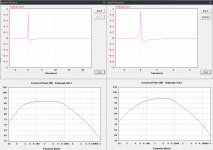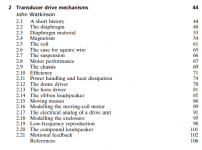Those good folks in Northridge clearly need to get themselves some camplofication 😀
We've had this topic (Bass performance) come up several times over in this thread....and every time it ends up here....
SD, Power handling and Xmax........ Actually I am one trying to make it more complicated...I always bring up rigidity and now I would probably add BL.
...JBL 2234 vs 2235 drivers. The are identical except for the mass ring in the 2235.
Rob🙂
Looking at the 2 woofers....simulate these woofers in identical boxes....next check how many SPL each drivers gets per Mm of excursion....notice how it is identical.

If anyone in this thread would like to spend a little time riding the pine, let me know, I’d be happy to oblige, just keep it up.
With the Oberton 15NMB600 sim'd in the 230l box the Qtc turns out to be 0.23
What should I take from this? 0.5 is critical but from discussion here I've gathered that qtc, at times is desired to be even lower. For the Bass reproduction the room Q has final say. This woofer is really starting to be mainly a bridge between the 18H+'s on the bottom and the horn...
On the other foot, the AE15m response crossed very well to the 18h+...It may be the best decision to stick with the AE15m even if I have to end up with a 8ohm version to get the Thiele specs right.
What should I take from this? 0.5 is critical but from discussion here I've gathered that qtc, at times is desired to be even lower. For the Bass reproduction the room Q has final say. This woofer is really starting to be mainly a bridge between the 18H+'s on the bottom and the horn...
On the other foot, the AE15m response crossed very well to the 18h+...It may be the best decision to stick with the AE15m even if I have to end up with a 8ohm version to get the Thiele specs right.
Last edited:
Since this is all custom, seems like you'd want a 16 ohm system to keep current draw/thermal power distortion low.
Regarding a diaphragm...Imagine being able to adjust mass and rigidity independently from each other...whats the use of adding mass?
Well with some nice tools like Hornresp, VituixCAD or Akabak, you can actually do this and observe the resulting changes in magnitude response, group delay, and so on when keeping the 'box' the same.

Perhaps give it a try?
If you'd like to know the 'why' for the differing results you'll see, there's always those books that keep getting brought up.😀
lol point me to the book that explains it and I'll look it up....I think I have a firm enough grasp on physics to grasp the basics.....a 0 mass, infinity rigidity, diaphragm, is the holy grail.... "Every" aspect has harmonic characteristics it seems (dimension/mass/Geometrical configuration/volume/density/etc) So if one can separately adjust mass of an infinitely rigid diaphragm.....they would intend to tap into a mode placed where they intend to use the diaphragm...modes come with drawbacks not just increased sensitivity.
"Imagine being able to adjust mass and rigidity independently from each other...whats the use of adding mass?" - could you just explain your main point, in words, if you have any?
- The point has been made regarding reading a book(s). Here, we, are having a conversation "out loud" where you could just get to the point by saying what it is that you know, or point directly to the info....ie book and page number. Its like we've created, in this thread, a new "book" from many other "books"....Book - ": something that yields knowledge or understanding". Please don't hate on my book lol, just contribute if you can. Its like together we are a super computer of thoughts. If you read this thread you'll see this same concept playing out from the get go....Literally the first response to my very first post could have been "Just go read these books!" Followed by a list of books, and immediately there after a moderator could have locked the thread because further discussion is useless because I have the list of books already. Here we've been able to stream line the information into a drawn out conversation via text and pictures. Theres even some audio samples lol. Things have stayed very positive for a long amount time and many people have participated and very interesting conversation has been had.there's always those books that keep getting brought up.
"Imagine being able to adjust mass and rigidity independently from each other...whats the use of adding mass?" - could you just explain your main point, in words, if you have any?
Last edited:
camplo .. are we referring to a drivers "MMS" calculation here? That figure is more than just cone weight. There's the whole assembly that is included as well as the volume of air (its weight) that the cone is pushing against.
Thats a very good question...because both figures affect F...I think in the example of the 2 jbl woofers were just talking Mmd.
Last edited:
Since this is all custom, seems like you'd want a 16 ohm system to keep current draw/thermal power distortion low.
Well GM the 18h+'s can be wired in 16ohm....16ohm was not available in Axi, but I did want a 16ohm tweeter....and I have a 16ohm td15M.....but it seems Qes AND Qtc is 0.7 instead of 0.3.....The way this driver is meant to be used is much more dependent on Le but the original plan was to end up with a qtc of 0.5
Attachments
Loudspeakers and Headphone handbook by John Borwick would be a good place to start. I have a feeling that Ro808 has even gifted it in this thread if not the internet can provide to get you started quickly.lol point me to the book that explains it and I'll look it up
I'm sure this or any book doesn't explain everything you might want to know but the conversation might be easier to continue.
Attachments
lol point me to the book that explains it and I'll look it up....
I have given a couple of books multiple times by now (in this thread even), seems you still didn't spent much time on those........
https://www.diyaudio.com/forums/mul...m-spl-low-distortion-2-a-870.html#post6825524
To expand on your (very good) recommendations with a psychoacoustics book that’s actually fun to read for those who aren’t happy looking at pages of just equations:
Acoustics and Psychoacoustics - David M. Howard, Jamie Angus - Google Books
As to the final line in the reply to my previous comment; my point is that you can use a large number of tools with a lumped element model of a transducer, and freely put whatever value you'd like in for Mms/Mmd, or Kms, or any other parameter.
The diagram I included shows an electrical equivalent circuits (resistor, capacitors and inductors) which can be used to determine the radiated output of a transducer, at low to mid frequencies at least.
That is covered in various levels within the books recommended so far in this thread, and the papers from that era (1900-1930) are all open access at this point, too.
Even if you don't go to read the text, you can at least move a single value up and down and see the effect on the response.
Acoustics and Psychoacoustics - David M. Howard, Jamie Angus - Google Books
As to the final line in the reply to my previous comment; my point is that you can use a large number of tools with a lumped element model of a transducer, and freely put whatever value you'd like in for Mms/Mmd, or Kms, or any other parameter.
The diagram I included shows an electrical equivalent circuits (resistor, capacitors and inductors) which can be used to determine the radiated output of a transducer, at low to mid frequencies at least.
That is covered in various levels within the books recommended so far in this thread, and the papers from that era (1900-1930) are all open access at this point, too.
Even if you don't go to read the text, you can at least move a single value up and down and see the effect on the response.
Those good folks in Northridge clearly need to get themselves some camplofication 😀





Since this is all custom, seems like you'd want a 16 ohm system to keep current draw/thermal power distortion low.
I also thought about pairs of 8 ohm 15m's to create the 16 ohm load...Weltersys made the comment about having 100hz emanate from two separate sources (spread so far apart) might not sound so good...so wind died on that sail.... a MTM with horn in the middle of course.
Art's comment was slightly more nuanced in that it was referencing the listening distance of 1m or 2m, that having such a large spacing would not be ideal. This goes back to what was said before about the distance it takes for the drivers to integrate as designed and why most nearfield or midfield monitors are smaller.
The Kinoshita main monitors use that exact layout successfully but are not designed to be listened to up close.
The Kinoshita main monitors use that exact layout successfully but are not designed to be listened to up close.
To expand on your (very good) recommendations with a psychoacoustics book that’s actually fun to read for those who aren’t happy looking at pages of just equations:
Acoustics and Psychoacoustics - David M. Howard, Jamie Angus
Last edited:
Art's comment was slightly more nuanced in that it was referencing the listening distance of 1m or 2m, that having such a large spacing would not be ideal. This goes back to what was said before about the distance it takes for the drivers to integrate as designed and why most nearfield or midfield monitors are smaller.
The Kinoshita main monitors use that exact layout successfully but are not designed to be listened to up close.
Phase correction should make it possible to listen to such a design, up close and personal.
Two large sources spread apart not combining nicely in the nearfield isn't something that can be solved with any form of "correction".Phase correction should make it possible to listen to such a design, up close and personal.
- Home
- Loudspeakers
- Multi-Way
- Is it possible to cover the whole spectrum, high SPL, low distortion with a 2-way?

